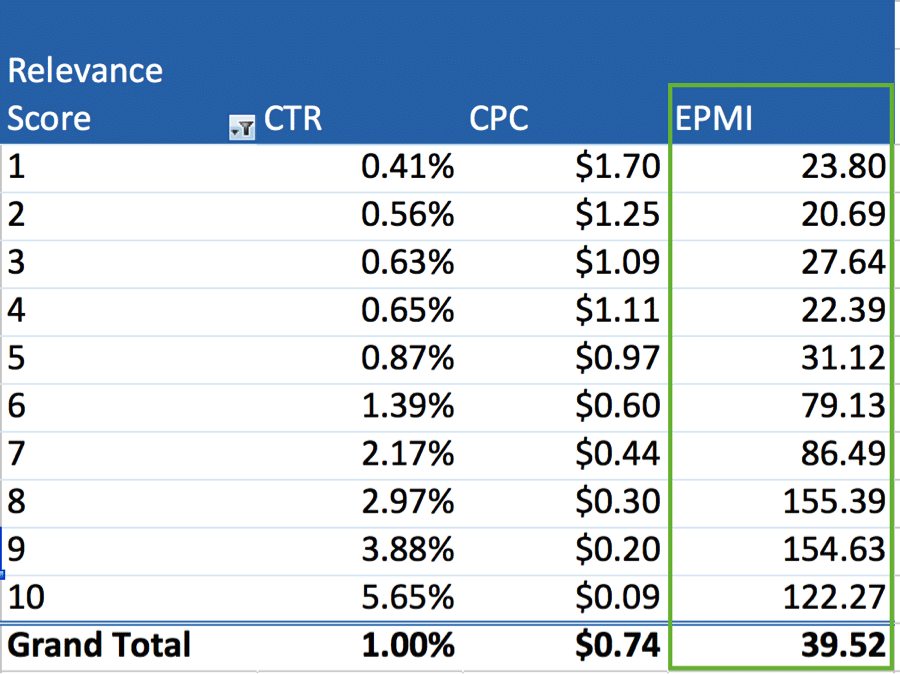In an attempt to better understand Facebook relevance score (FBRS), AIMCLEAR conducted an in-depth research study, based on data collected over a 5-month period, to determine how FBRS affected ad performance. The results are undeniable. In this post we’ll cover the top 5 takeaways to increase your score.
Relevance Score was rolled out in February by Facebook to measure how germane an ad is to its target audience. Facebook makes it a priority to display relevant content to its users — FBRS is a tangible representation of that mission. Since Facebook thrives or fails based on its customers, advertisers would be wise to take this score into account when creating ads and audience segments. Creating ads that are not relevant to the target audience is a sure fire way to drive negative responses and limit ad exposure. Cost will skyrocket while advertisers are forced to pay premiums for clicks Facebook considers irrelevant.
Putting Data To The Test
The FBRS study analyzed anonymized data mined from thousands of ads created by AIMCLEAR between February and June. One thing became very clear: The higher the FBRS, the higher the click through rate (CTR) and the lower the cost per click (CPC).
We reviewed engagements per 1,000 impressions (EPMI) as a metric, which helps us determine how engaging ads are to audiences to which they are displayed. There is a huge jump in EPMI as relevance scores grow, improving from 23.80 EPMI at a relevance score of 1, to 122.27 EPMI at a relevance score of 10.
It’s important for advertisers to remember Facebook determines relevance score not based on how relevant the ad is to the landing page, but rather how relevant the ad is to the target audience. Facebook helps advertisers by providing a rating based on positive and negative user interactions with the ad.
A positive interaction can be a completion of an advertising goal, such as website clicks, as well as positive social interactions, such as likes and shares. Negative interactions occur when a user chooses to hide an ad or report it for offensive content. We were intrigued to find that positive interactions with ads have a larger impact on FBRS than negative.
Facebook reports positive and negative feedback as “high,” “medium,” or “low.” Ads with a high rating for positive feedback saw the largest impact to FBRS.
Everyone take a deep breath. Alrighty then, let’s go. The first part of this post focused on why FBRS is important, but we also promised we would get into some tactical steps marketers can take to improve their score. Fear not, because at AIMCLEAR we are people of our word, so next let’s look at a few steps savvy Facebook technicians can use to increase the score.
Know Your Audience
FBRS is all about how relevant your content is to the intended audience. This is almost impossible to achieve if there isn’t a clear understanding of who that audience is. There is a plethora of ways to understand your audience, including ad testing, surveys, social channel feedback and Facebook Insights. Finding out what kind of content an audience wants to consume —and presenting it in an easy way for them to consume — is crucial. Facebook analyzes the way an audience interacts with an ad when determining FBRS, so smart businesses will stack the deck by creating highly engaging content that is sure to be of interest to their audience.
Use Interest Targeting to Pinpoint Perfect Audiences
Utilizing custom and lookalike audiences has been a common practice for marketers for a while now. This is a great tool for creating audiences that, in theory, are already interested in a company’s product or service. Why not take it one step further and overlay interest targeting to further segment audiences into smaller groups of highly targeted people? This allows marketers to get even more granular in their ad content in hopes of making it irresistible to users.
For example, a shoe retailer has a customer rewards program that captures a customer’s email address. They can then import that email list into Facebook and create a custom and look-alike audience from the list. This will create an audience that by all accounts should be interested in the products they stock. Unfortunately when the retailer runs Facebook ads, they’re speaking to a very broad audience, so it’s hard to create pinpointed ads that are going to drive engagement from the audience as a whole. This will lead to a low FBRS and possibly higher CPCs. However, if that same retailer created smaller audiences by layering interests over the look-alike audience based on different brands, then they’re able to create highly targeted ads to an audience that has already indicated they’re interested in that specific brand. By relation, this will lead to higher engagement by the user and a higher score for the advertiser.
Focus on Engagement
This step is fundamental — most Facebook marketers are already doing it, but it’s still an important step. Create content that users want to engage with. While conversions based on campaign goals are important, advertisers can’t forget about other social engagements such as likes and shares. Creating content that users want to share with their friends not only is a great way to increase your advertising reach, but also the quickest way to increase positive feedback, leading to higher relevance scores.
Track Positive and Negative Feedback
Tracking positive and negative feedback can be beneficial on two different fronts. Firstly, because relevance score is calculated using feedback, it’s important to know an ad’s rating. Secondly, the positive and negative ratings can help marketers get a better understanding of their audience, as well as what kind of content the audience wants to consume.
Advertisers can track positive and negative feedback at the ad level. It’s important to remember that Facebook doesn’t calculate relevance 
Consistently Test and Optimize
The last step is something that smart marketers have been doing since the beginning of time: testing and optimizing. Since Facebook is going to take the time to provide a relevance score, and we’ve determined that it does indeed have an effect on account performance, use it! Track relevance score for your ads and use that number to test against when creating new ads. Use the relevance score to optimize your ads for user engagement and positive/negative feedback. Doing so will help advertisers create content that will not only drive positive results from users, but will also increase relevance score and decrease cost.
FBRS can be a great tool for Facebook marketers looking to determine an ad’s effectiveness. Relevance score not only tracks how audiences are interacting with an ad, but can also have a direct impact on ad cost. Savvy Facebook marketers will use this score as a way to create highly engaging ads that lead customers into the conversion funnel.
References
- http://www.wordstream.com/quality-score
- https://www.facebook.com/business/news/relevance-score
- http://www.adweek.com/socialtimes/relevance-score-positive-negative-feedback-ad-insights/439648
- https://www.facebook.com/business/news/audience-insights
- https://www.driftrock.com/blog/facebook-advertising-guide-lookalike-audiences
- http://blog.wishpond.com/post/55704754460/12-easy-ways-to-find-engaging-facebook-content-my
Image Copyright in Shutterstock: omihay, Jane Kelly, Creativa Images















